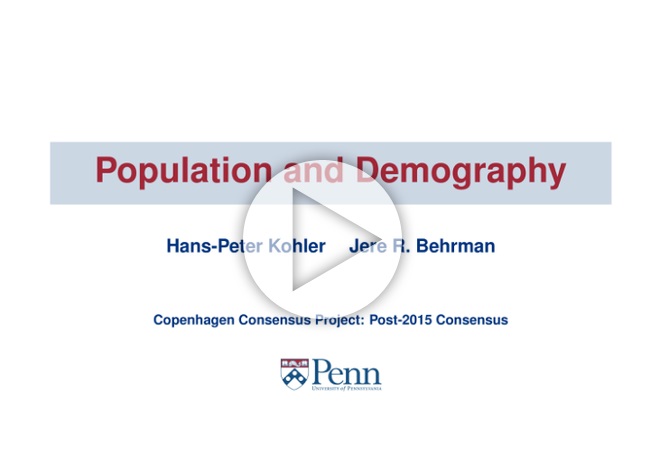Indonesia Perspectives: Population and Demography
Seminar Speakers:
- Hans-Peter Kohler, Professor of Demography in the Department of Sociology and a Research Associate in the Population Studies Center at the University of Pennsylvania
- Dwini Arianto, Vice Director of the Indonesia Demographic Institute
Seminar Presentation by Hans-Peter Kohler:
Background
Indonesia is the fourth most populous country in the world and will be eighth in the list of countries contributing to population growth by 2050 (other than African countries, only India, Pakistan and the USA come higher). The birth rate fell steeply in the last decades of the Twentieth Century, but has stalled since the mid-90s, with women on average bearing 2.6 children, or about half a child more than needed to simply keep numbers stable over time.
With continuing significant population growth, it will not seem surprising that a target recommended in the Copenhagen Consensus study is to make family planning available to everyone. Although it is very difficult to do a rigorous economic assessment of the costs and benefits of achieving this, we estimate that every 1,000 IDR of spending would pay back between twenty- and thirty-fold.
But access to contraception, in Indonesia at least, is not primarily about reducing population growth. It turns out that, even if fertility rates dropped to replacement levels (2.1 children per mother) tomorrow, population growth up to 2050 would be barely affected. This so-called population momentum is simply due to the large number of women of child-bearing age. Life expectancy is likely to rise to 77.4 years (from 71.2) by 2050, and the population is set to rise to 321 million.
As long as the country can capitalise on the fact that there will be a large fraction of the population of working age over coming decades – what is known as the demographic dividend – Indonesia has much to gain from a population which will continue to grow until mid-century. Over time, the proportion of people over 65 will increase as the number below 15 falls, but in the meantime the large number of young and middle-aged adults can give a real boost to the economy. But it is still important to see fertility rates decline so that dependency ratios (numbers of old and young people supported by those of working age) remain low enough for the benefits of the demographic dividend to be felt.
The real benefit of broadening access to contraception will come in reducing the maternal mortality rate, one of the highest in the region at 470 deaths per 100,000 live births. For comparison, Malaysia has a maternal death rate less than 10% of that of Indonesia. Expansion of family planning is expected to avoid 5,400 deaths of mothers in childbirth and 336,000 infant deaths over a five year period.
Better family planning has other benefits as well: less childbearing should result in more education for girls and young women, a general improvement in women’s health, a greater number of women in paid jobs, lower child mortality and generally improved childhood health, and more time for mothers to devote to the children they do have. It’s no surprise, then, to see the return of dua anak cukup’ commercials, in a bid to fulfil the remaining unmet need for family planning (estimated at 11% of the total) and reduce the rate of births to teenage mothers in rural areas.
There are also other ways to contribute to the growth of prosperity. The total number of international migrants grew from 103 million in 1980 to 230 million in 2013. 36% of this total – over 82 million people – moved from one developing country to another. This includes, for example, Indonesians working in Saudi Arabia, and the more than one million workers from Indonesia in Malaysia.
Overall, wealth is generated by workers moving to countries where they can be more productive, and the families of migrants benefit directly via remittances. The boost to host economies is, however, spread more thinly and there are local workers who may lose out, so it is important that migration is well managed to allow adjustment. The overall benefits are still clear, however, and reducing barriers to migration is a target which would be highly relevant for Indonesia; the benefit for every thousand rupiah spent is likely to be around 45,000 IDR.
There are other inescapable trends which have to be recognised and made the most of. Towns and cities will continue to grow rapidly in low- and middle-income countries. This can create problems, but there are also opportunities for higher productivity and better healthcare and schooling, so it is important for urbanisation to be properly managed to maximise the gains. Similarly, the inevitable aging of the population calls for policies which improve both health and lengthen working lives.
Indonesia’s population will continue to grow for the next few decades but, properly managed, this can create both economic growth and better welfare.


